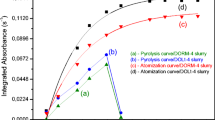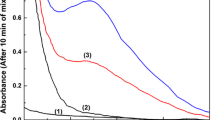Summary
A method of the determination of mercury and copper in food is described. The digestion is carried out with sulfuric acid, nitric acid and hydrogenperoxide under refluxing to prevent losses of mercury. Mercury and copper were extracted by dithizone from acid solution. Copper can be analysed directly by the one-color-method at 571 nm, because mercury does not absorb at this wavelength. Determination of mercury needs the separation of the dithizonats. In this step dithizone and the oxydation products were removed, otherwise they could simulate a higher mercury content. We developed two new steps to cause separation: first a thin-layer purification and second a adsorption chromatography separation with sodiumhydrogencarbonate as an adsorbens. The mercury content of 118 kinds of in Austria commercial available fish-and mussel preserves were analysed by this method.
Zusammenfassung
Eine Methode zur Bestimmung von Quecksilber und Kupfer in Lebensmitteln wird beschrieben. Der Aufschluß erfolgt mit Schwefelsäure, Salpetersäure und Wasserstoffperoxid unter Rückfluß, um Verluste flüchtiger Quecksilberverbindungen zu vermeiden. Quecksilber und Kupfer werden als Dithizonate aus saurer Lösung extrahiert.
Im Dithizonextrakt kann nach dem Einfarbenverfahren Kupfer direkt bei 571 nm bestimmt werden, da bei dieser Wellenlänge Quecksilberdithizonat nicht absorbiert. Zur Bestimmung von Quecksilber ist eine Trennung der Dithizonate notwendig. Gleichzeitig werden Dithizon und seine Oxydationsprodukte entfernt, die andernfalls erhöhte Quecksilbergehalte vortäuschen können. Als wesentliche Neuerung entwickelten wir zur Trennung zwei Methoden, die dies ermöglichten, und zwar eine dünnschichtchromatographische und eine adsorptionschromatographische Trennung, bei der Natriumhydrogencarbonat als Adsorbens eingesetzt wurde. Mit dieser Methode wurden 118 Sorten in Österreich im Handel befindlicher Fisch- und Muschelkonserven hinsichtlich ihres Quecksilbergehaltes untersucht.
Similar content being viewed by others
Literatur
Westöö, G., Rydälo, M.: Rep. Int. Inst. Publ. Health Stockholm 1969.
Nuorteva, Naturw. Rundschau24, (6), 233 (1971).
Westöö, G.: Acta chew. Scand.21, 1790 (1967).
Westöö, G.: Var Föda7, 138 (1969).
Berglund, F., Wretlind, A.: Var Föda1, 9 (1967).
Wegler, R.: Chemie der Pflanzenschutz- und Schädlingsbekämpfungsmittel. Band 2. Berlin-Heidelberg-New York: Springer 1970.
Szolnik, M., Hickey, K.D., Broderick, E.J., Lisk, D.J.: Plant Disease Reptr.49, (7), 568 (1965).
Jacobs, H.B.: Am. Ind. Hyg. Assoc. J.21, 475 (1960).
Dandell, E. B.: Colorimetric determination of traces of metals, 3. Auflage. New York-London: Interscience Publishers 1959.
Grigorescu, J., Martinescu, Y., Toba, G.: Rev. Chim. (Bucharest)17, 368 (1966).
Gutmann, W.H., Lisk, D.J.: J. Agr. Food Chem.8, 306 (1960).
Klein, A. K.: J. Assoc. Offic. Agr. Chemists35, 537 (1952).
Roth, F.J.: J. Assoc. Offic. Agr. Chemists40, 302 (1957).
Nagy, M.: Deut. Lebensm. Rundschau67, 297 (1971).
Bönig, G.: Landwirtsch. Forsch.22, 285 (1969).
Iwantscheff, G.: Das Dithizon und seine Anwendung in der Mikro- und Spurenanalyse. Weinheim: Chemie-Verlag 1958.
Wichmann, H.J.: Ind. Eng. Chem.11, 66 (1938).
AOAC-Arbeitsvorschrift Nr. 24059–24065/1965.
Koch, O.G., Koch-Dedic, G.A.: Handbuch der Spurenanalyse. Berlin-Heidelberg-New York: Springer 1964.
Bäumler, J., Rippstein, S.: Mitt. Gebiete Lebensm. Hyg.54, 472 (1963).
Erämetsä, O.: Suomen Kemistilehti16 B, 13 (1943).
Author information
Authors and Affiliations
Additional information
Diese Arbeit wurde aus Mitteln des Forschungsförderungsfonds der gewerblichen Wirtschaft Österreichs gefördert.
Rights and permissions
About this article
Cite this article
Woidich, H., Pfannhauser, W. Zur quantitativen Bestimmung von Quecksilber in biologischem Material. Z Lebensm Unters Forch 149, 1–7 (1972). https://doi.org/10.1007/BF01461377
Received:
Issue Date:
DOI: https://doi.org/10.1007/BF01461377




